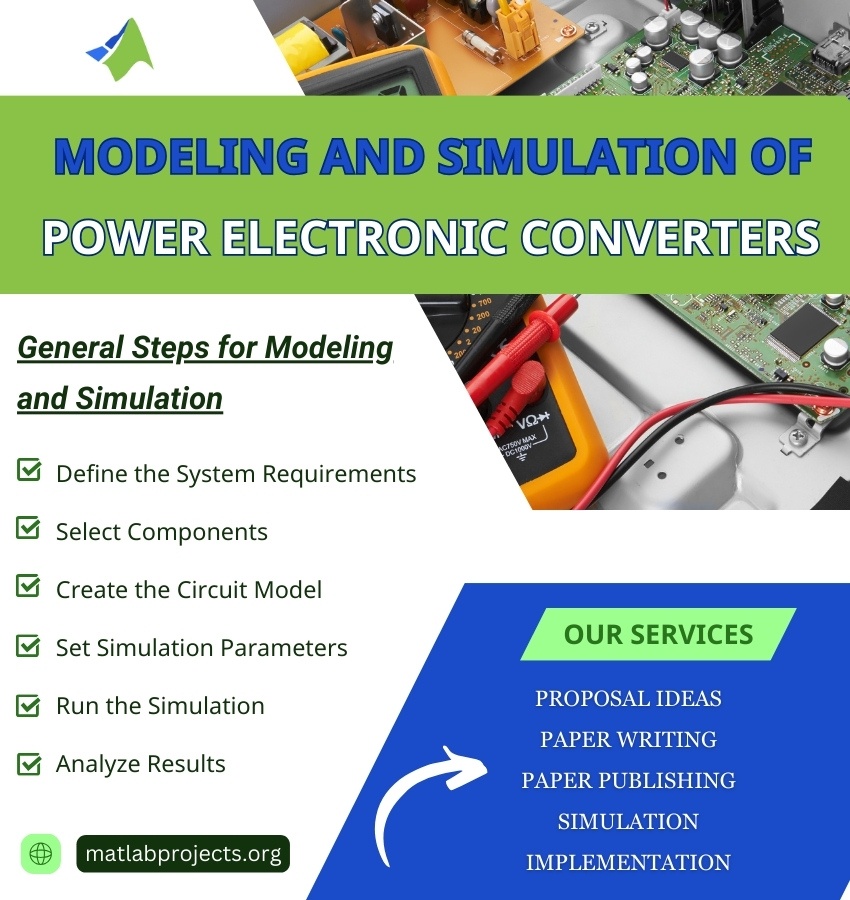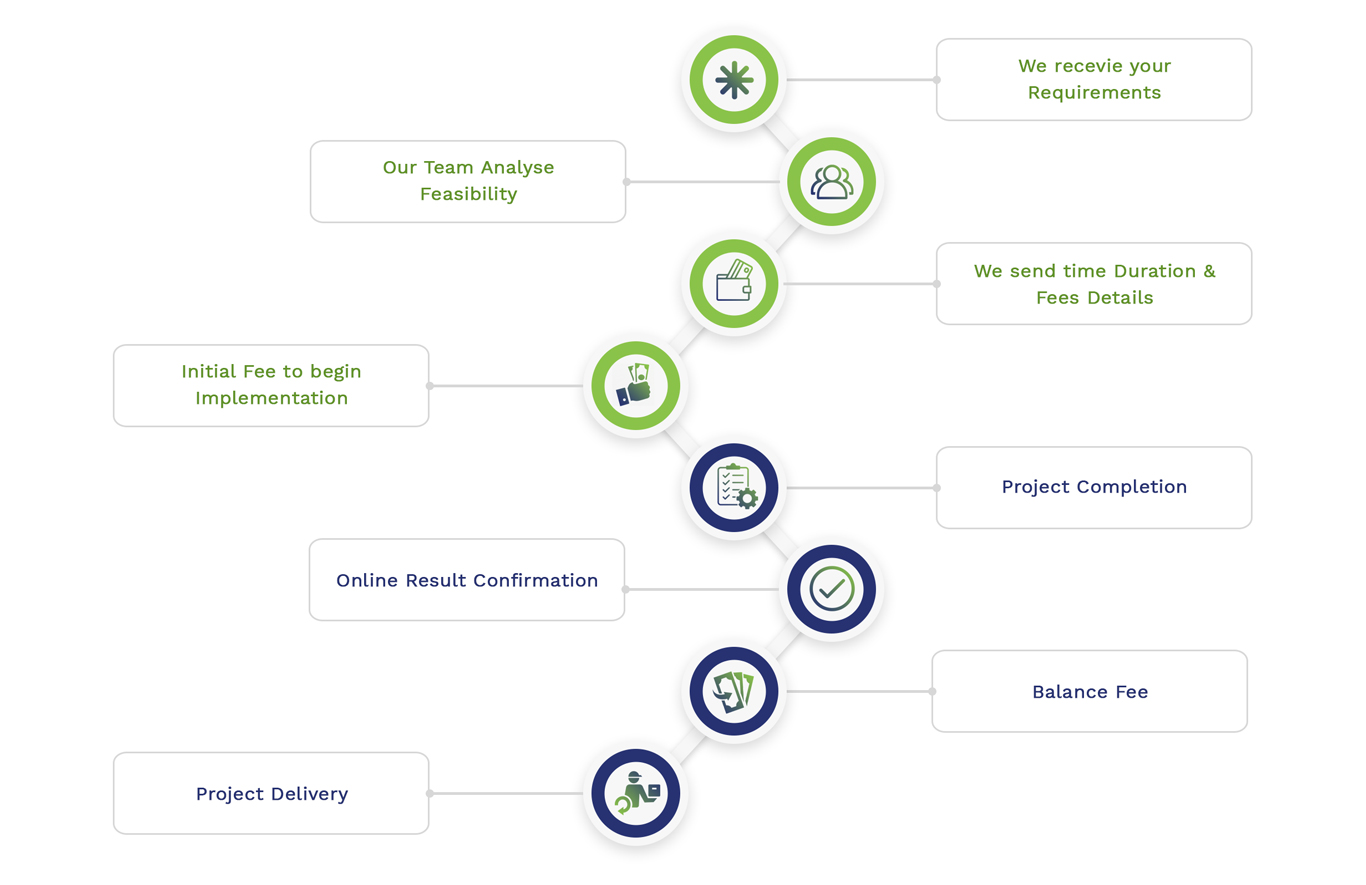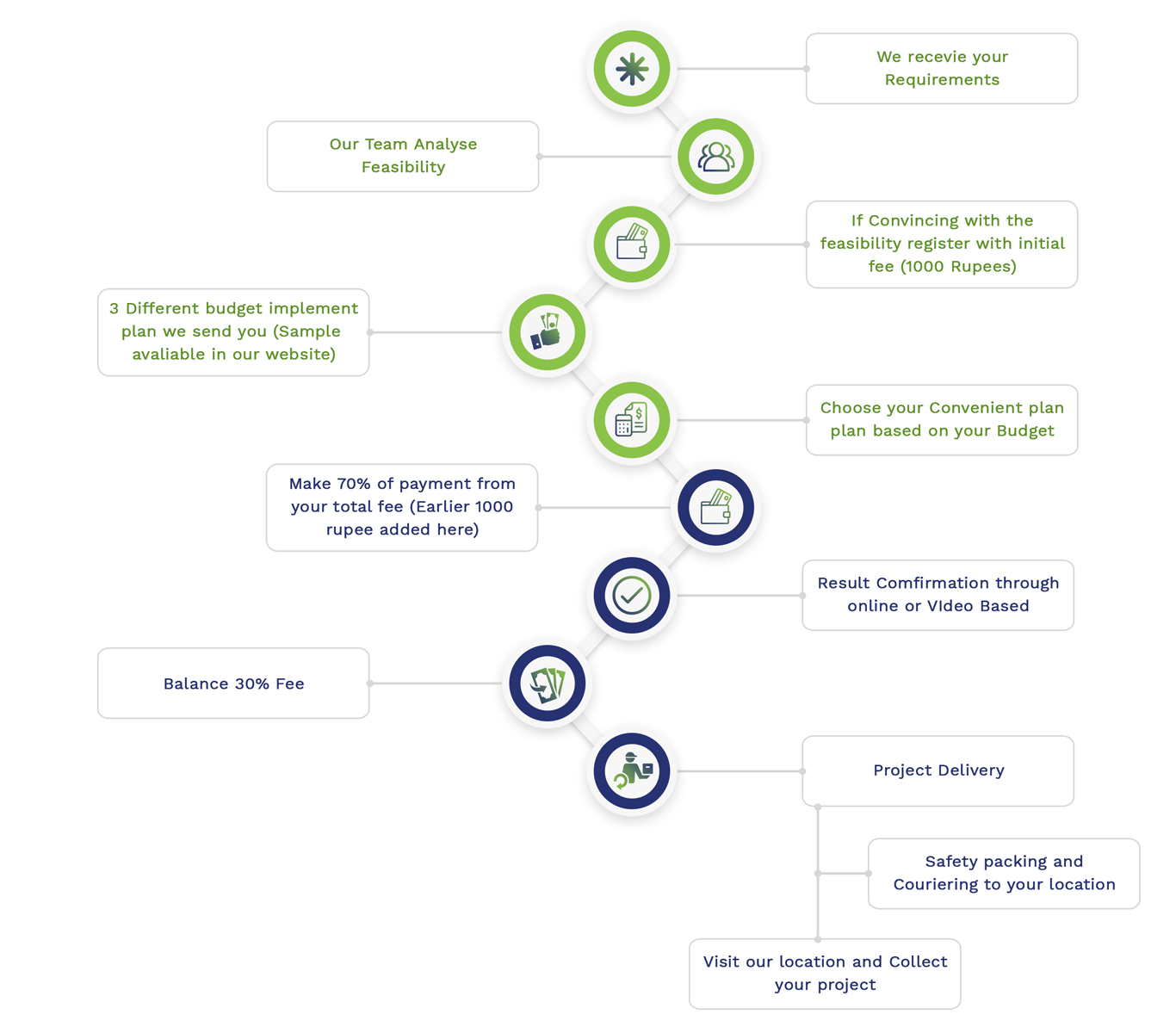Modeling And Simulation of Power Electronic Converters is an intriguing approach that has to be conducted by following several procedures. To design and simulate power electronic converters, we offer an extensive instruction, along with some instances, simulation tools, and realistic procedures:
- Introduction to Power Electronic Converters
To transform and regulate electrical power in an effective way, power electronic converters are highly utilized. On the basis of their operations, they are categorized into different kinds:
- DC-DC Converters: DC voltage can be transformed to another DC voltage through these converters.
- AC-DC Converters (Rectifiers): It specifically transforms AC voltage to DC voltage.
- DC-AC Converters (Inverters): DC voltage can be transformed to AC voltage by means of these converters.
- AC-AC Converters: With various frequency and/or amplitude, it transforms AC voltage to another AC voltage.
- Simulation Tools
For the simulation of power electronic converters, MATLAB/Simulink is employed in an extensive manner because of having an enormous library of tools and blocks to design electrical frameworks. Some of the other major tools are PSpice, LTspice, and PSIM.
- Common Procedures for Modeling and Simulation
- Specify the System Necessities: The performance measures, input/output conditions, and the kind of converter have to be detected.
- Choose Elements: Suitable elements must be selected. It could include controllers, capacitors, inductors, diodes, and switches.
- Build the Circuit Model: We plan to utilize simulation tools to develop the circuit. Note that every element should be depicted in a precise manner.
- Set Simulation Parameters: Focus on specifying the preliminary states, solver settings, and simulation duration.
- Execute the Simulation: Then, the simulation has to be executed appropriately. Based on major metrics like current, voltage, and effectiveness, we have to gather essential data.
- Examine Outcomes: To evaluate the performance of the converter, examine the simulation data. For further enhancement, detect potential areas.
- Instances of Power Electronic Converters
Instance 1: DC-DC Buck Converter
Goal: To minimize a 24V DC input to a 12V DC output, a buck converter has to be modeled and simulated.
Elements:
- Capacitor (C): 100 µF
- Inductor (L): 100 µF
- Resistive Load (R_load): 10 Ω
- Diode
- PWM Controller
- MOSFET (Switch)
Simulation Procedures:
- Open Simulink: First, we have to initiate the MATLAB tool and open Simulink.
- Build the Circuit:
- For the voltage source, inductor, diode, capacitor, MOSFET, and load resistor, include blocks.
- In order to design the buck converter circuit, link all the elements.
- Set Parameters:
- PWM Frequency: 50 kHz
- Voltage Source: 24V
- Duty Cycle: 50%
- Execute the Simulation: Execute the simulation by fixing the time duration to 0.05 seconds.
- Examine Outcomes:
- Through the analysis process, make sure that the output voltage waveform maintains approximately 12V.
- Across the inductor, verify for current and voltage ripple.
Sample Simulation Code:
% Define Parameters
V_in = 24; % Input Voltage
R_load = 10; % Load Resistance
L = 100e-6; % Inductance
C = 100e-6; % Capacitance
f_pwm = 50e3; % PWM Frequency
D = 0.5; % Duty Cycle
% Create Simulink Model
model = ‘buck_converter’;
open_system(new_system(model));
% Add Components
add_block(‘powerlib/Elements/DC Voltage Source’, [model ‘/DC Voltage Source’], ‘Position’, [100, 100, 150, 150]);
add_block(‘powerlib/Elements/Ideal Switch’, [model ‘/MOSFET’], ‘Position’, [200, 100, 250, 150]);
add_block(‘powerlib/Elements/Diode’, [model ‘/Diode’], ‘Position’, [200, 200, 250, 250]);
add_block(‘powerlib/Elements/Inductor’, [model ‘/Inductor’], ‘Position’, [300, 100, 350, 150]);
add_block(‘powerlib/Elements/Capacitor’, [model ‘/Capacitor’], ‘Position’, [400, 100, 450, 150]);
add_block(‘powerlib/Elements/Resistor’, [model ‘/Load’], ‘Position’, [500, 100, 550, 150]);
% Connect Components
add_line(model, ‘DC Voltage Source/1’, ‘MOSFET/1’);
add_line(model, ‘MOSFET/2’, ‘Inductor/1’);
add_line(model, ‘Inductor/2’, ‘Capacitor/1’);
add_line(model, ‘Capacitor/2’, ‘Load/1’);
add_line(model, ‘Load/2’, ‘DC Voltage Source/2’);
add_line(model, ‘MOSFET/1’, ‘Diode/1’);
add_line(model, ‘Diode/2’, ‘Inductor/2’);
% Set Simulation Parameters
set_param([model ‘/DC Voltage Source’], ‘Voltage’, num2str(V_in));
set_param([model ‘/Inductor’], ‘Inductance’, num2str(L));
set_param([model ‘/Capacitor’], ‘Capacitance’, num2str(C));
set_param([model ‘/Load’], ‘Resistance’, num2str(R_load));
% Run Simulation
sim(model, ‘StopTime’, ‘0.05’);
% Plot Results
simout = get_param(model, ‘SimulationOutput’);
V_out = simout.logsout.getElement(‘Capacitor’).Values.Data;
figure;
plot(V_out);
xlabel(‘Time (s)’);
ylabel(‘Output Voltage (V)’);
title(‘Buck Converter Output Voltage’);
Instance 2: AC-DC Rectifier
Goal: As a means to transform AC voltage to DC voltage, a single-phase full-wave rectifier must be simulated.
Elements:
- Capacitor
- Diodes
- Transformer
- Load Resistor
Simulation Procedures:
- Create the Circuit: Using Simulink, we develop a single-phase rectifier circuit.
- Set Parameters:
- Input AC voltage: 230V RMS, 50 Hz
- Filter capacitor: 1000 µF
- Transformer turns ratio: 10:1
- Load resistance: 100 Ω
- Execute the Simulation: For 0.1 seconds, carry out the simulation process.
- Examine Outcomes:
- The DC output voltage and ripple have to be evaluated.
- Concentrate on examining power factor and effectiveness of the rectifier.
Sample Simulation Code:
% Define Parameters
V_in = 230; % Input AC Voltage
R_load = 100; % Load Resistance
C = 1000e-6; % Capacitance
f_ac = 50; % AC Frequency
% Create Simulink Model
model = ‘ac_dc_rectifier’;
open_system(new_system(model));
% Add Components
add_block(‘powerlib/Elements/AC Voltage Source’, [model ‘/AC Voltage Source’], ‘Position’, [100, 100, 150, 150]);
add_block(‘powerlib/Elements/Diode’, [model ‘/Diode1’], ‘Position’, [200, 50, 250, 100]);
add_block(‘powerlib/Elements/Diode’, [model ‘/Diode2’], ‘Position’, [200, 150, 250, 200]);
add_block(‘powerlib/Elements/Capacitor’, [model ‘/Capacitor’], ‘Position’, [300, 100, 350, 150]);
add_block(‘powerlib/Elements/Resistor’, [model ‘/Load’], ‘Position’, [400, 100, 450, 150]);
% Connect Components
add_line(model, ‘AC Voltage Source/1’, ‘Diode1/1’);
add_line(model, ‘Diode1/2’, ‘Capacitor/1’);
add_line(model, ‘AC Voltage Source/2’, ‘Diode2/1’);
add_line(model, ‘Diode2/2’, ‘Capacitor/2’);
add_line(model, ‘Capacitor/1’, ‘Load/1’);
add_line(model, ‘Load/2’, ‘Capacitor/2’);
% Set Simulation Parameters
set_param([model ‘/AC Voltage Source’], ‘Voltage’, num2str(V_in), ‘Frequency’, num2str(f_ac));
set_param([model ‘/Capacitor’], ‘Capacitance’, num2str(C));
set_param([model ‘/Load’], ‘Resistance’, num2str(R_load));
% Run Simulation
sim(model, ‘StopTime’, ‘0.1’);
% Plot Results
simout = get_param(model, ‘SimulationOutput’);
V_out = simout.logsout.getElement(‘Load’).Values.Data;
figure;
plot(V_out);
xlabel(‘Time (s)’);
ylabel(‘Output Voltage (V)’);
title(‘AC-DC Rectifier Output Voltage’);
Instance 3: DC-AC Inverter
Goal: In order to transform DC voltage to AC voltage appropriate for energizing AC loads, a single-phase DC-AC inverter should be modeled and simulated.
Elements:
- PWM Controller
- H-Bridge Inverter
- Load
- Filter
Simulation Procedures:
- Develop the Circuit: Through the use of Simulink, we build an H-Bridge inverter circuit.
- Set Parameters:
- DC Input Voltage: 400V
- Filter components: L and C
- Output Frequency: 50 Hz
What are some good projects related to audio processing for an electrical engineering student?
In the domain of audio processing, numerous project ideas have emerged based on various requirements. Appropriate for an electrical engineering scholar, we list out some compelling projects relevant to audio processing, along with a concise explanation, goals, possible results, and ideas to execute them in an efficient manner:
- Design and Implementation of a Digital Equalizer
Aim: To adapt the amplitude of various frequency bands in an audio signal, a digital equalizer has to be modeled and applied.
Elements:
- Filters (Band-pass, Low-pass, High-pass)
- Digital Signal Processor (DSP)
- Audio input and output interface.
Procedures:
- Model Filters: For various frequency bands, we intend to develop digital filters.
- Implementation: To apply the filters, make use of software such as MATLAB or a DSP.
- Testing: Different audio signals have to be included. To analyze variations in audio standard, adapt the equalizer configurations.
Anticipated Results:
- Acquire knowledge based on the model and application of filters.
- For expected sound effects, it could offer capability to control audio signals.
Tools: Simulink, MATLAB, or a DSP development board.
- Noise Cancellation System
Aim: For actual-time minimization or removal of background noise from audio signals, our project aims to create a framework.
Elements:
- Noise cancellation method (for instance: Adaptive Filtering)
- Microphones
- Audio input and output interface
Procedures:
- Gather data: By including and excluding noise, record audio.
- Algorithm Creation: To eliminate the noise, apply adaptive filtering approaches.
- Testing: In various constraints, the efficiency of noise cancellation has to be assessed.
Anticipated Results:
- Enhanced interpretation on actual-time signal processing and adaptive filtering approach.
- To minimize background noise, it can provide a functional model.
Tools: DSP hardware, Python, or MATLAB.
- Real-Time Audio Spectrum Analyzer
Aim: As a means to depict the frequency spectrum of an audio signal in a visual manner, we create an actual-time audio spectrum analyzer.
Elements:
- FFT Algorithm
- Microphone
- Display Interface
Procedures:
- Signal Acquisition: Through the utilization of a microphone, seize audio signals.
- Frequency Analysis: To transform the time-domain signal into a frequency-domain depiction, employ FFT.
- Visualization: On a computer or a screen, demonstrate the frequency spectrum.
Anticipated Results:
- For actual-time visualization of audio frequencies, it could offer a tool.
- Expertise in Fast Fourier Transform (FFT) and frequency analysis.
Tools: Python along with libraries such as Matplotlib and NumPy, Simulink, and MATLAB.
- Speech Recognition System
Aim: For the conversion of spoken words into text format, a speech recognition framework must be created.
Elements:
- Machine learning Model
- Microphone
- Feature Extraction Methods (for example: MFCC).
Procedures:
- Data Gathering: Audio data has to be gathered, including different spoken words.
- Feature Extraction: From the audio data, retrieve characteristics such as MFCC (Mel-Frequency Cepstral Coefficients).
- Model Training: To identify and categorize the speech characteristics, focus on training a machine learning model.
Anticipated Results:
- In order to identify and translate spoken words, this project could suggest a working model.
- Gain knowledge of feature extraction and speech processing.
Tools: Python including major libraries such as librosa, Keras, and TensorFlow.
- Digital Audio Effects Processor
Aim: Specifically for audio signals, various digital effects such as echo, reverb, and distortion have to be modeled and applied.
Elements:
- Digital Signal Processor (DSP)
- Audio input and output interface
- Audio Effects Algorithms
Procedures:
- Algorithm Creation: Suitable digital effects algorithms must be applied.
- Combination: The algorithms have to be combined with a software platform or DSP.
- Testing: To different audio signals, implement effects. Then, the outcomes should be assessed.
Anticipated Results:
- Provide expertise based on digital signal processing for audio effects.
- To implement different audio effects, it could offer a software or device.
Tools: A DSP development board, Simulink, or MATLAB.
- Audio Compression and Decompression System
Aim: To compress and decompress audio signals, create an efficient framework which minimizes file size without compromising quality.
Elements:
- Audio Codec Implementation
- Audio Compression Algorithm (for instance: AAC, MP3)
- Audio input and output interface.
Procedures:
- Algorithm Creation: Plan to utilize previous audio compression methods or create new ones.
- Compression: Focus on compressing audio data. Then, the compression ratio has to be assessed.
- Decompression: The audio data must be decompressed. With the actual data, compare the standard of the decompressed data.
Anticipated Results:
- In order to show efficient audio compression and decompression, this project could suggest a model.
- Explicit interpretation of audio compression approaches.
Tools: Python along with audio libraries such as PyDub, and MATLAB.
- Design of a Digital Audio Mixer
Aim: For enabling actual-time integration of several audio signals, we develop a digital audio mixer.
Elements:
- Mixing Algorithms
- Multiple Audio Inputs
- Output Interface
Procedures:
- Input Acquisition: Several audio inputs have to be seized.
- Integration: As a means to combine and stabilize the audio signals, apply methods.
- Output: Through a recording device or speaker, output the integrated audio signal.
Anticipated Results:
- It is possible to acquire expertise in actual-time audio processing and integration.
- For different applications, it could provide a working digital audio mixer.
Tools: Dedicated hardware, Python, or MATLAB.
- Audio Watermarking System
Aim: With the aim of securing intellectual property, create a framework, which is capable of inserting and extracting digital watermarks in audio signals.
Elements:
- Watermarking Algorithm
- Audio input and output interface
Procedures:
- Algorithm Creation: An efficient audio watermarking method has to be applied.
- Embedding: Within an audio signal, insert a watermark.
- Extraction: From the altered audio signal, retrieve the watermark.
Anticipated Results:
- For securing and validating audio content, it could suggest a tool.
- Gain knowledge of audio watermarking approaches.
Tools: Python and MATLAB.
- Design of a Digital Hearing Aid
Aim: For individuals with hearing problems, a digital hearing aid has to be modeled, which enhances and filters audio signals.
Elements:
- DSP for Audio Processing
- Microphone
- Amplifier and Earphone
Procedures:
- Signal Processing: To enhance and filter audio signals, we apply suitable methods.
- Combination: Within a compact device, combine the elements.
- Testing: Using different audio signals, assess the hearing aid. For efficient performance, adapt it.
Anticipated Results:
- For hearing aids, it could provide interpretations of signal processing.
- Particularly for hearing enhancement, a functional model could be examined.
Tools: DSP hardware and MATLAB.
- Voice-Activated Smart Home System
Aim: A voice-activated framework must be created, which utilizes speech commands to regulate household appliances.
Elements:
- Speech Recognition Module
- Microphone
- Control Interface for Appliances
Procedures:
- Speech Recognition: Previous speech recognition software has to be employed or executed.
- Command Processing: To understand commands and regulate appliances, we create a framework.
- Combination: To different household appliances, integrate the framework.
Anticipated Results:
- Obtain skills in home automation and voice recognition.
- To respond to voice commands, it can suggest a smart home framework.
Tools: Raspberry Pi, Python, and MATLAB.

Modeling And Simulation of Power Electronic Converters Topics
Modeling And Simulation of Power Electronic Converters Topics where we share with you the significant metrics and complete explanation with simulation support are shared by matlabprojects.org. We offer assistance for your project related to modeling, design, and control schemes for power electronics. If you encounter any confusion at any stage, we are committed to providing you with the best support. Read the Modeling And Simulation of Power Electronic Converters Topics worked by us and get your tailored topic from our researchers.
- Comparative assessment of four low voltage fault ride through techniques (LVFRT) for wind energy conversion systems (WECSs)
- Closing the gap between wind energy targets and implementation for emerging countries
- Policies toward net-zero: Benchmarking the economic competitiveness of nuclear against wind and solar energy
- Fretting wear and fatigue in submarine power cable conductors for floating offshore wind energy
- Enhanced Gaussian Process Regression for Diagnosing Wind Energy Conversion Systems
- Observation analysis of wind climate in China for 1971–2017 under the demand of wind energy evaluation and utilization
- A novel deep reinforcement learning enabled sparsity promoting adaptive control method to improve the stability of power systems with wind energy penetration
- A framework for preliminary large-scale urban wind energy potential assessment: Roof-mounted wind turbines
- Measurement and analysis of wind energy potential using fuzzy based hybrid MADM approach
- Adaptive super-twisting terminal sliding mode control and LVRT capability for switched reluctance generator based wind energy conversion system
- A multi-objective probabilistic approach for smart voltage control in wind-energy integrated networks considering correlated parameters
- The development of an assessment framework to determine the technical hydrogen production potential from wind and solar energy
- Potential environmental effects of deepwater floating offshore wind energy facilities
- Implications of offshore wind energy developments in coastal and maritime tourism and recreation areas: An analytical overview
- New perspectives on maximum wind energy extraction of variable-speed wind turbines using previewed wind speeds
- Optimizing wind energy conversion efficiency with respect to noise: A study on multi-criteria wind farm layout design
- Assessment of wind energy resources in the urat area using optimized weibull distribution
- Cascaded dual fuzzy logic controller for stable microgrid operation mitigating effects of natural uncertainty in solar and wind energy sources
- Future projections of offshore wind energy resources in China using CMIP6 simulations and a deep learning-based downscaling method
- Solar and wind energy in Poland as power sources for electrolysis process – A review of studies and experimental methodology
Subscribe Our Youtube Channel
You can Watch all Subjects Matlab & Simulink latest Innovative Project Results
Our services
We want to support Uncompromise Matlab service for all your Requirements Our Reseachers and Technical team keep update the technology for all subjects ,We assure We Meet out Your Needs.
Our Services
- Matlab Research Paper Help
- Matlab assignment help
- Matlab Project Help
- Matlab Homework Help
- Simulink assignment help
- Simulink Project Help
- Simulink Homework Help
- Matlab Research Paper Help
- NS3 Research Paper Help
- Omnet++ Research Paper Help
Our Benefits
- Customised Matlab Assignments
- Global Assignment Knowledge
- Best Assignment Writers
- Certified Matlab Trainers
- Experienced Matlab Developers
- Over 400k+ Satisfied Students
- Ontime support
- Best Price Guarantee
- Plagiarism Free Work
- Correct Citations
Expert Matlab services just 1-click

Delivery Materials
Unlimited support we offer you
For better understanding purpose we provide following Materials for all Kind of Research & Assignment & Homework service.
 Programs
Programs Designs
Designs Simulations
Simulations Results
Results Graphs
Graphs Result snapshot
Result snapshot Video Tutorial
Video Tutorial Instructions Profile
Instructions Profile  Sofware Install Guide
Sofware Install Guide Execution Guidance
Execution Guidance  Explanations
Explanations Implement Plan
Implement Plan
Matlab Projects
Matlab projects innovators has laid our steps in all dimension related to math works.Our concern support matlab projects for more than 10 years.Many Research scholars are benefited by our matlab projects service.We are trusted institution who supplies matlab projects for many universities and colleges.
Reasons to choose Matlab Projects .org???
Our Service are widely utilized by Research centers.More than 5000+ Projects & Thesis has been provided by us to Students & Research Scholars. All current mathworks software versions are being updated by us.
Our concern has provided the required solution for all the above mention technical problems required by clients with best Customer Support.
- Novel Idea
- Ontime Delivery
- Best Prices
- Unique Work
Simulation Projects Workflow

Embedded Projects Workflow



 Matlab
Matlab Simulink
Simulink NS3
NS3 OMNET++
OMNET++ COOJA
COOJA CONTIKI OS
CONTIKI OS NS2
NS2






